Isotonic osmolarity - Study guides, Class notes & Summaries
Looking for the best study guides, study notes and summaries about Isotonic osmolarity? On this page you'll find 507 study documents about Isotonic osmolarity.
Page 4 out of 507 results
Sort by
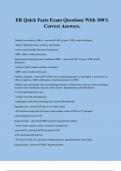
-
ER Quick Facts Exam Questions With 100% Correct Answers.
- Exam (elaborations) • 62 pages • 2024
-
- $14.49
- + learn more
ER Quick Facts Exam Questions With 100% Correct Answers. Diabetic ketoacidosis (DKA) - answer-MC in type 1 DM, insulin deficiency -Triad of hyperglycemia, acidosis, and ketones -fruity acetone breath, Kussmaul respirations -SIPS: saline, insulin, potassium Hyperosmolar hyperglycemic syndrome (HHS) - answer-MC in type 2 DM, insulin deficiency -similar to DKA without acidosis or ketones -SIPS: saline, insulin, potassium Diabetes insipidus - answer-ADH is not secreted adequately, or the k...

-
BIO 669- Quiz 1 Practice Questions and Correct Answers
- Exam (elaborations) • 12 pages • 2024
-
Available in package deal
-
- $9.99
- + learn more
How much of the body's water is intracellular? 2/3 How much of the body's water is extracellular? 1/3 Interstitial: 75% Intravascular: 25% Smaller amountsL sweat, urine, transcellular Populations susceptible to dehydration: Pediatric and geriatric Net filtration forces favoring filtration minus forces opposing filtration Aquaporins small pores in cells that allow for water transport across plasma membrane Solute Electrolytes/proteins Solvent Water/plasms Osmolarity Concentration of osmo...
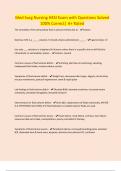
-
Med Surg Nursing HESI Exam with Questions Solved 100% Correct| A+ Rated
- Exam (elaborations) • 33 pages • 2024
-
- $13.39
- + learn more
The osmolality of the extracellular fluid is almost entirely due to - Sodium Dextrose 10% is a _____ solution. It should only be administered _____ - hyperosmolar; IV Use only ___ solutions in irrigations & infusions unless there is a specific aim to shift fluid to intracellular or extracellular spaces. - isotonic, neutral Common causes of fluid volume deficit. - Vomiting, diarrhea, GI suctioning, sweating, inadequate fluid intake, massive edema, ascites Symptoms of fluid volume deficit - ...
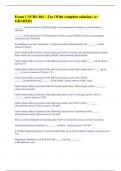
-
Exam 1 NURS 404 – Fox (With complete solution; A+ GRADED)
- Exam (elaborations) • 48 pages • 2023
- Available in package deal
-
- $15.49
- + learn more
_______ is the movement of fluid through a semi-permeable membrane. correct answers Osmosis _______ is the movement of solutes/particles from an area of higher to lesser concentration. correct answers Diffusion If something is isotonic, hypotonic, or hypertonic these labels describe the _______. correct answers Tonicity Fluid volume deficit (FVD or hypovolemia) is the loss of (circle one) intracellular/extracellular fluid volume that exceeds the intake of fluid. correct answers Extracel...
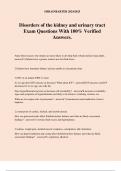
-
Disorders of the kidney and urinary tract Exam Questions With 100% Verified Answers.
- Exam (elaborations) • 14 pages • 2024
-
- $11.49
- + learn more
Disorders of the kidney and urinary tract Exam Questions With 100% Verified Answers. Name three reasons why infants are more likely to develop fluid volume deficits than adults. - answer1) Infants have a greater surface area for fluid losses 2) Infants have immature kidneys and are unable to concentrate urine 3) 80% of an infants TBW is water As we age does ECF increase or decrease? What about ICF? - answerECF increases and ICF decreases b/c as we age, our cells die Does hypochloremia i...
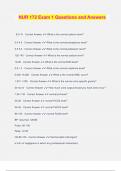
-
NUR 172 Exam 1 Questions and Answers
- Exam (elaborations) • 17 pages • 2024
- Available in package deal
-
- $12.49
- + learn more
NUR 172 Exam 1 Questions and Answers 8.5-10 - Correct Answer ️️ -What is the normal calcium level? 3.0-4.5 - Correct Answer ️️ -What is the normal phosphorus level? 3.5-5.0 - Correct Answer ️️ -What is the normal potassium level? 135-145 - Correct Answer ️️ -What is the normal sodium level? 10-20 - Correct Answer ️️ -What is the normal BUN level? 0.6-1.2 - Correct Answer ️️ -What is the normal creatinine level? 5,000-10,000 - Correct Answer ️️ -What is the norm...
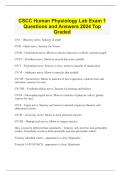
-
CSCC Human Physiology Lab Exam 1 Questions and Answers 2024 Top Graded
- Exam (elaborations) • 6 pages • 2024
-
- $12.99
- + learn more
CN I - Olfactory nerve, Sensory of smell CN II - Optic nerve, Sensory for Vision CN III - Oculomotor nerve, Motor to muscles that move eyeball, constricts pupil CN IV - Trochlear nerve, Motor to muscle that move eyeball CN V - Trigeminal nerve, Sensory to face, motor to muscles of mastication CN VI - Abducens nerve, Motor to muscles that eyeball CN VII - Facial nerve, Motor to muscles of face expression, controls tears and salivation, sensory for taste CN VIII - Vestibulocoh...
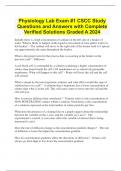
-
Physiology Lab Exam #1 CSCC Study Questions and Answers with Complete Verified Solutions Graded A 2024
- Exam (elaborations) • 12 pages • 2024
-
- $14.99
- + learn more
Initially there is a high concentration of sodium on the left side of a beaker of water. What is likely to happen (with regard to movement of ions and/or water) in this beaker? - The sodium will move to the right side of the beaker until it is spread out approximately the same throughout the beaker. What is the proper term for the process that is occurring in the beaker on the previous card? - Diffusion A red blood cell is surrounded by a solution containing a higher concentration of solut...

-
NUR 376 Patho Final Questions and Answers 2024
- Exam (elaborations) • 19 pages • 2024
- Available in package deal
-
- $7.99
- + learn more
Immunodeficiency - Answer-Immune system weakened to extent that it cannot destroy foreign invaders and antigens can overwhelm the body. Immunocompetence - Answer-refers to an individual's ability to protect oneself from infectious agents due to a strong immune system. Immunosuppression - Answer-indicates that there is a defective immune system that is putting the pt at risk for infection. Opportunistic Infection - Answer-an infection that was caused by a microorganism that flourished bec...

-
PNB 2250 Exam 3 Uconn Questions and Correct Answers | Latest Update
- Exam (elaborations) • 10 pages • 2024
- Available in package deal
-
- $10.49
- + learn more
The loss of digestive wastes, CO2 and NH4+ are examples of _______________. -:- excretion The regulation of H2O and solutes is via ___________________. -:- osmoregulation Water moves from an area of ________ (low, high) osmolarity to an area of __________ (low, high) osmolarity -:- low, high ___________: a chemical dissolved in a solvent (H2O is the only solvent we are interested in) [6.02]. ___________s occupy space within H2O -:- solute Osmolarity : measure of the number of ___...

Did you know that on average a seller on Stuvia earns $82 per month selling study resources? Hmm, hint, hint. Discover all about earning on Stuvia


